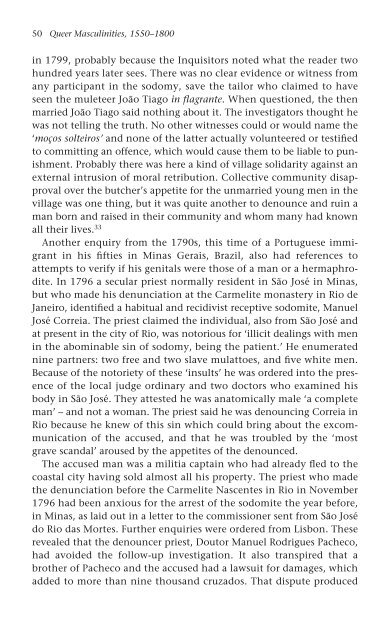queer masculinities
queer masculinities
queer masculinities
You also want an ePaper? Increase the reach of your titles
YUMPU automatically turns print PDFs into web optimized ePapers that Google loves.
50 Queer Masculinities, 1550–1800<br />
in 1799, probably because the Inquisitors noted what the reader two<br />
hundred years later sees. There was no clear evidence or witness from<br />
any participant in the sodomy, save the tailor who claimed to have<br />
seen the muleteer João Tiago in flagrante. When questioned, the then<br />
married João Tiago said nothing about it. The investigators thought he<br />
was not telling the truth. No other witnesses could or would name the<br />
‘moços solteiros’ and none of the latter actually volunteered or testified<br />
to committing an offence, which would cause them to be liable to punishment.<br />
Probably there was here a kind of village solidarity against an<br />
external intrusion of moral retribution. Collective community disapproval<br />
over the butcher’s appetite for the unmarried young men in the<br />
village was one thing, but it was quite another to denounce and ruin a<br />
man born and raised in their community and whom many had known<br />
all their lives. 33<br />
Another enquiry from the 1790s, this time of a Portuguese immigrant<br />
in his fifties in Minas Gerais, Brazil, also had references to<br />
attempts to verify if his genitals were those of a man or a hermaphrodite.<br />
In 1796 a secular priest normally resident in São José in Minas,<br />
but who made his denunciation at the Carmelite monastery in Rio de<br />
Janeiro, identified a habitual and recidivist receptive sodomite, Manuel<br />
José Correia. The priest claimed the individual, also from São José and<br />
at present in the city of Rio, was notorious for ‘illicit dealings with men<br />
in the abominable sin of sodomy, being the patient.’ He enumerated<br />
nine partners: two free and two slave mulattoes, and five white men.<br />
Because of the notoriety of these ‘insults’ he was ordered into the presence<br />
of the local judge ordinary and two doctors who examined his<br />
body in São José. They attested he was anatomically male ‘a complete<br />
man’ – and not a woman. The priest said he was denouncing Correia in<br />
Rio because he knew of this sin which could bring about the excommunication<br />
of the accused, and that he was troubled by the ‘most<br />
grave scandal’ aroused by the appetites of the denounced.<br />
The accused man was a militia captain who had already fled to the<br />
coastal city having sold almost all his property. The priest who made<br />
the denunciation before the Carmelite Nascentes in Rio in November<br />
1796 had been anxious for the arrest of the sodomite the year before,<br />
in Minas, as laid out in a letter to the commissioner sent from São José<br />
do Rio das Mortes. Further enquiries were ordered from Lisbon. These<br />
revealed that the denouncer priest, Doutor Manuel Rodrigues Pacheco,<br />
had avoided the follow-up investigation. It also transpired that a<br />
brother of Pacheco and the accused had a lawsuit for damages, which<br />
added to more than nine thousand cruzados. That dispute produced


